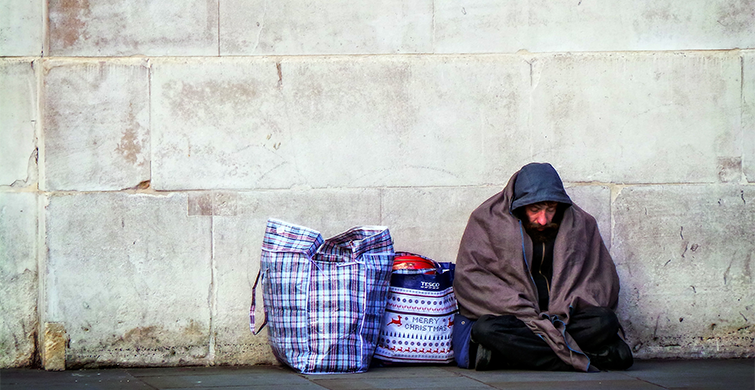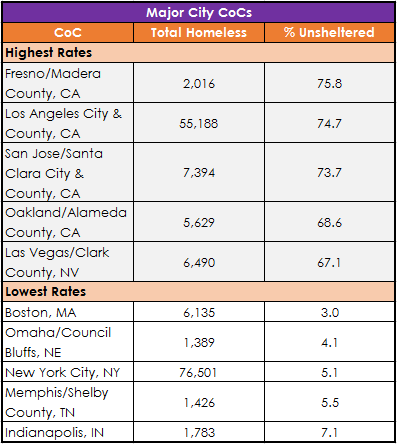Local and National Trends in Homelessness

From 2016 to 2017, the number of people experiencing homelessness increased for the first time in seven years. While the total increase was slightly less than 1%, it reversed a trend of decreasing homelessness, and there was a 9% increase in the number of people experiencing unsheltered homelessness.
The Department of Housing and Urban Development’s Annual Homeless Assessment Report (AHAR) provides point-in-time estimates of the number of sheltered and unsheltered homeless individuals on a single night in January. Each year, local communities count these individuals, in addition to counting the number of beds and services available to them, and report the data to HUD. The local planning bodies responsible for coordinating the full range of homelessness services in a geographic area are called Continuums of Care (CoC).
AHAR data is available on PolicyMap at both the state and, newly added, the CoC level. CoCs vary in size and area, though there’s generally one for each big city or its metro area, and regional CoCs for suburban and rural areas.
During 2017’s count, 553,743 people experienced homelessness in the United States – that’s 17 out of every 10,000 people in the country. 55% of all people experiencing homelessness resided in one of five states: California (25%), New York (16%), Florida (6%), Texas (4%), or Washington (4%). California and New York had significantly higher rates of homelessness than the national average – 34 and 45 people per 10,000, respectively.
While most (65%) of the homeless population stayed in emergency shelters or transitional housing, more than one third (35%) spent the night in locations not designed for sleeping, such as the streets, parks, and vehicles. Here is a closer look at the states with the highest and lowest rates of unsheltered people experiencing homelessness in 2017:

Four of the five highest rates of homeless people experiencing unsheltered homelessness in major city CoCs were in California. The major city CoCs with the lowest rates were unsurprisingly in colder areas (Massachusetts, Nebraska, etc.).

While homelessness did increase between 2016 and 2017, the rate per 10,000 was the lowest value on record because overall population grown outpaced the growth of homelessness. Additionally, the number of homeless people declined substantially since 2007 across every major category of homelessness nationally.

Let’s take a closer look at Illinois. At the state level, 10,798 people experienced homelessness on a given night in January 2017. Broken down by CoC, however, we see the population’s geographic distribution; 5,657 homeless people (or 52.4% of Illinois’ homeless population) lived in the Chicago CoC. Understanding which areas serve high concentrations of the homeless population would help determine appropriate resource distribution, and where to focus prevention efforts.
The National Alliance to End Homelessness recommends that communities take a coordinated approach, “moving from a collection of individual programs to a community-wide response that is strategic and data driven. Communities that have adopted this approach use data about the needs of those experiencing homelessness to inform how they allocate resources, services, and programs.” Some of the key elements of a coordinated approach include: coordinated entry, planning, collecting and examining local data, using a shared data system, and creating performance measurement and evaluation.
This data is open to the public and can be found in the Demographics Menu under “Homelessness”. The full report is available here. Data is made available by the US Department of Housing and Urban Development.
Photo Credit: Gary Knight via flickr, CC BY 2.0